What’s in a name? part 2

In the last blog I talked about how vital Latin names are to botanical illustrators, natural history and Sciart practitioners and enthusiasts. We covered Kingdoms, Phylum, Class, Order and Family. In this blog we’re looking at the two components of an organism’s Latin name – the genus and the species.
Genus and species
Now we get down to the Latin names as you see them written. A genus name followed by a species name. This is referred to as the scientific name of an organism. It is written in italics with the genus capitalised, the species name not capitalised. You may see Latin names underlined, not italicised. This is more common in hand writing than typing. Also, once you’ve written a Latin name out in full once, you can use an initial for the genus name next time you mention it. So Quercus robur can be Q. robur on its second mention.
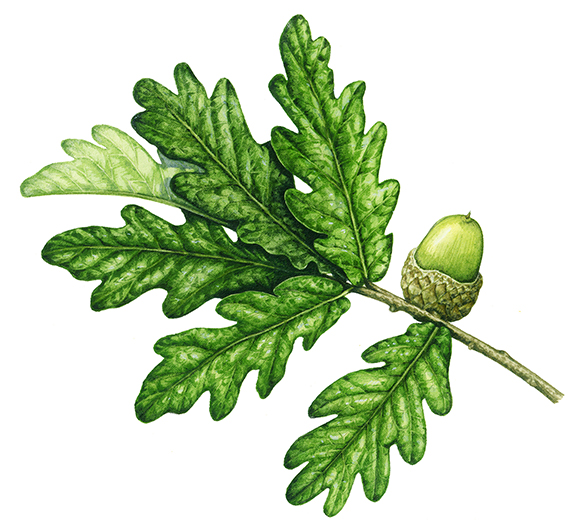
The English oak, Q. robur
Kingdom: Plantae, Phylum: Angiosperms, (no Class, please see my last blog for reasons why!) Order: Fagales, Family:Fagaceae, Genus: Quercus, Species: robur
G is for Genus
Genus refer to closely related species. We’re getting pretty specific, and there’s a high level of shared genetic material and relatedness by the time an organism is classified to genus level. All Oaks are in the Quercus genus.
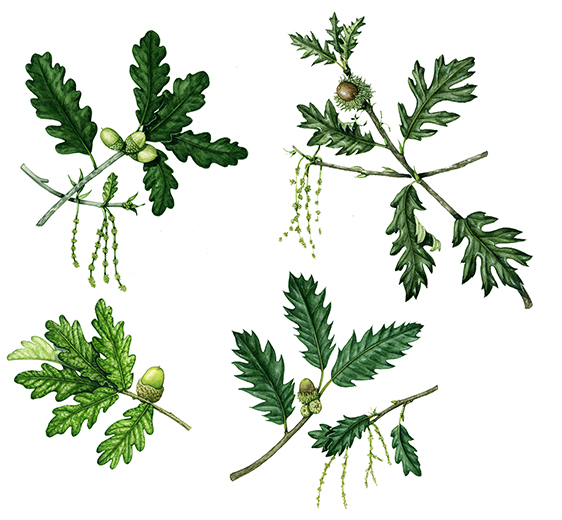
Four different species of Oak in the Quercus genus. (Clockwise from top L): Sessile oak Q. petraea, Turkey oak Q. cerris, English oak Q. robur, and the Luccombe oak Quercus x hispanica ‘Lucombeana’. (See below for an explanation of this latin name which gives information on hybridization, and a cultivar!).
Humans are in the genus Homo, along with several extinct hominids (Homo erectus, Homo habilis and others).
European land-breathing snails are all in the same genus (Helix). Our common garden snail H. aspersa is one of 17 individual species within this genus. The plural of genus is genera, and a genus name is written in italics with the first letter capitalised or, if using handwriting, may be underlined instead of italicised.
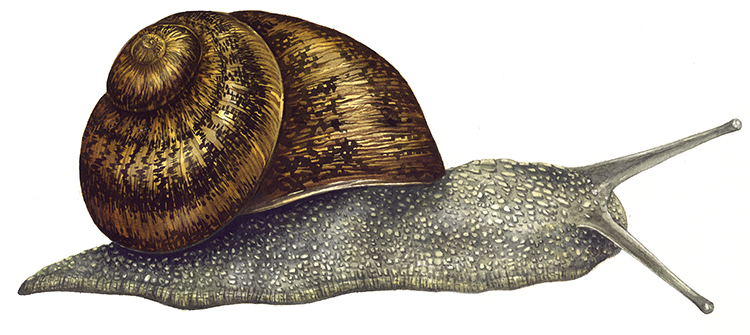
Helix aspersa, the Common garden snail (one of 17 species in the Helix Genus)
S is for species
Finally! This is where you can absolutely nail the identity of what you’re drawing or studying. There can be further distinctions (see below). But generally a species refers to one specific type of organism which breed and produce fertile offspring in nature. However, even this isn’t clear cut. Distinct species sometimes breed and produce fertile offspring (this is called hybridizing). This is true of the Hooded crow and the Carrion crow.
At species level I can figure out what precise organism I need to illustrate. If a client were simply to tell me to paint a sedge (genus Carex) I’d be lost. There are over 2000 known species! However, by giving me the species name I have the information required to get a specific and correct painting done.

Three species of sedge. The Brown sedge C. disticha, the Common sedge C. nigra, and the Wood sedge C. sylvatica
A good way to think of scientific names is as a noun (the genus) followed by a qualifier, or an adjective (the species name).
Scientific names can give lots of information
The English Oak we discussed earlier is Q. robur. Robur translates as strong, and clearly refers to the stout properties of English oak timber.
The sedges above offer another good example. Carex translates as sedge. Disticha literally translates as “couplets”. This refers to its flower (catkin for sedges) morphology. In the USA the common name for the plant is the “two-tier” sedge. Nigra translates as black. The catkin of this plant does indeed look very dark when compared to other sedge species. It also bears black seed heads. Sylvaticum, the species name of the Wood sedge translates loosely as “of the woods”.
Another example is the Vanessa brush-footed butterflies. The genus is Vanessa, within the 22 species of Vanessa you find the Andean Painted lady (Vanessa alitssima). The Latin name literally translates as the “highest” Vanessa butterfly, which makes sense considering it lives in the Andes. Vanessa braziliensis is, not surprisingly, the Brazilian Vanessa butterfly. The Painted lady butterfly we’re familiar with in the UK, Vanessa cardui, translates as the “thistle” Vanessa. One of its preferred food plants is thistle. Latin names are informative if you take the time to look at them.
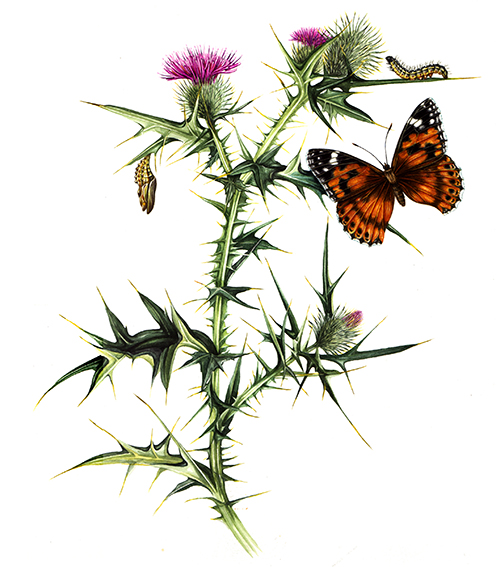
The Painted lady butterfly, V. cardui on host plant thistle
What is a subspecies?
Sometimes there will be consistent variations within a species, often relating to geographically separate populations of the same organism, or the presence of a common mutation or small difference from the norm. You can show this by following the species name with the abbreviation of “subspecies” which is “subsp.” So the Wild daffodil has the species name Narcissus pseudonarcissus. However, the plant is actually a subspecies, so to be accurate its Latin name must read Narcissus pseudonarcissus subsp. pseudocarcissus.
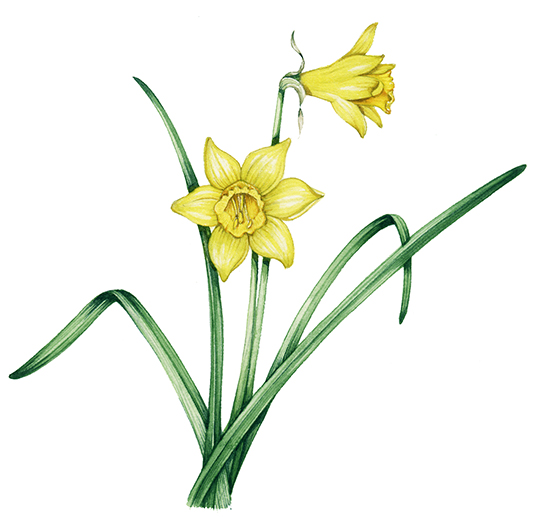
The Wild daffodil Narcissus pseudonarcissus subsp. pseudocarcissus
Hybridizing and Cultivars
Remember the mention of hybridizing species? The fact that two species have bred can be shown in in the offspring’s Latin name – a cross between the English oak (Q. robur) and the Sessile oak (Q. petraea) is Quercus petraea x robur. The “x” is the symbol used to show what parent species have mingled to create this hybrid.
Finally, for any gardeners among you, you’ll come across cutivar names. These follow the species name. They appear after the prefix “cultivar”, “cv” or quotation marks. Cultivar names tend to be in English, not Latin. They aren’t put in italics. With the Lucombe oak above, you can tell from its name that its a hybrid. It includes the tell-tale “x”. (Even though in this case, its parents, the Turkey and Cork oak aren’t mentioned in its name). It is the ‘Lucombeana’ cultivar.
A clearer example is the King Edward potato. Its full name is: Solanum tuberosum cv. King Edward. To simplify, that’s the species Solanum tubersum; the“King Edward” cultivar.
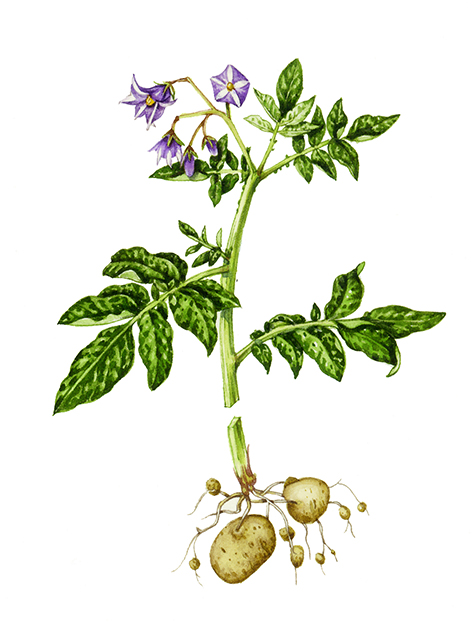
The King Edward potato cultivar Solanum tubersum “King Edward”.
For more on the naming of variants, cultivars, and forms of plants check out the BBC’s gardening page or Australia’s Virtual Herbarium help page on the subject.
The joy of latin names
At this point it’s worth mentioning that there’s a world of delight in Latin names; they are often very descriptive, relating to an organism’s habitat or leaf shape, colour of smell. But they are also sometimes very funny. Who can resist the fact that the North American kangaroo mouse’s Latin name is Microdipodops megacephalus which translates as “a thing that looks as though it has two small feet with a big head”. This, and many other similar examples can be found in the thoroughly engaging book on Latin names by John Wright (which I was lucky enough to illustrate); “The Naming of the Shrew: A curious history of Latin names”.
The “tip card” from the Institure for Analytical Plant Illustration (IAPI) on naming and classifying plants has been invaluable for these linked blogs, these cards come on many subjects and are well worth investing in.

